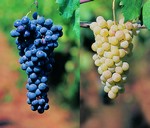The (Not-So) Weekly Wino: December 14th
As the cool has settled in and the summer's sweaty nights are long gone, my affection for wine has left white and turned as red as the leaves on the vines. My cravings for fish having been well-satisfied with the abundance of the sea on the table here in Southern Italy, I now have "voglia di carne" (lit trans: I have want of meat).
This is a seasonal adaptation for me as I am loyal to all colors in the wine spectrum. My first consideration when choosing a wine is what is on my plate, and sometimes what is on my plate may be determined by whether I have a mood for bianco or rosso.
But these winter months for me mean that my house is often filled the scent of a slow stew, and my bones need to be warmed by red wine. Being in Campania, I feel that it is my duty to talk about our wines that are all too often overlooked in the international market. In the past I've written about Greco di Tufo, a biancolella/fiano blend from Ischia, and even vino paesano. Now it's aglianico's turn.
Aglianico (ahl-YAN-eeko) is an ancient red grape that is believed to have been brought by the Phoenicians. It is also grown to great success in Basilicata under the Aglianico del Vulture D.O.C.
In northwestern Campania lies the Falerno del Massico D.O.C. There is a designation for rosso (60-80% aglianico, 20-40% piedirosso, max 20% primitivo or barbera) rosso primitivo (at least 85% primitivo, max 15% aglianico with piedirosso/barbera), and bianco (100%
 falanghina).
falanghina).Villa Matilde is a Campanian producer credited with helping revive the Falerno region, and Vigna Camarato is their top rosso composed of 80% aglianico and 20% piedirosso. Its site is the oldest vineyard in their holding (Vigna, pronounced VEEN-ya, means vineyard, and this one's called Camarato) and it produces an age-worthy red to compete with the reds from the Taurasi D.O.C.G. (also aglianico-based, Campanian red with a little more finesse and a little less brawn, comparatively speaking).
Aglianico is typically a very tannic grape, blessing its wine with a great capacity for aging. Although Vigna Camarato could age for up to 15 years, I recently tried the 2001 bottling. The moment it hit my glass I knew it was going to be heavy. The color is a deep, loaded ruby-red and it moves in the glass like cream.

The scent is rich and deep, that of mature fruit and a hint of oak, which it could surely do better without. There is also a good bit of earth and black licorice. The tannins make their presence known, but they are fairly well-balanced by dark berry jam and licorice that wrap your mouth in fruit and leave you tasting the wine long after it's left your palate.
Vigna Camarato is not for the faint of heart. It's strong and burly in its youth and it won't let you forget that you should have left it alone for just a couple of years more. Placed next to a juicy beef braise or a rare steak though, you can put those tannins to work and make this youngster shine.
Finesse and delicacy will never be adjectives for this wine, but it'll keep you warm and maybe even give you a reason to be happy that Winter has just begun.
**Vigna Camarato retails in Italy for about 30 euro. Next week (but don't quote me on that) I'll introduce a budget aglianico.
Labels: Weekly Wino


8 Comments:
Tracie, are you aware that after your italian experience you won't be able to drink any wine in the US anymore?
Even the italian wines suck here. Same label, same wine... they suck.
I think it's because of the solphites that BY LAW have to be in any wine sold in the States, but that's just my guess.
Maybe that's something you could ask your expert friends.
Anyway, I don't touch any wine for a whole year here (it really disgusts me), and you can imagine how good the 1.75 euro bottle of falanghina or per-e-palumm (artigianale!) tastes when I go back to Napoli to see my parents...
I drink almost a bottle a day... without getting (particularly) drunk and without any kind of hangover at all!
Damn solphites...
12/14/2006 11:45 AM
hey cammar, even italians use sulphites! even if it's not an additive (there are some producers who succeed in avoiding it), it's a natural by-product of fermentation so every wine has at least a little.
i think you just miss italy :)
12/14/2006 12:25 PM
Very interesting post. I am trying to learn more about wine and your postings are molto helpful.
12/14/2006 12:49 PM
what an excellent, descriptive recommendation. i would like to see if there's a way to get some of this fabulous vino.
happy holiday!
erin
12/14/2006 8:41 PM
Cammar might be missing mama's cooking more than anything...
12/14/2006 10:28 PM
Tracie. . . I am an Italian who knows nothing about wine. . . except that I wish my brother and mother would make me some more red wine. . . thanks for the education.
Ciao
12/16/2006 6:37 AM
.Ok Now I am jealous. really jealous.
I will put your blog as a link on my blog..
I will read this daily
I will try to get, cook and eat these greens..I live in S philly...lots of italian immigrants here..maybe they know something about it. Keep on posting, PLEASE
http://thoughtscafe.blogstream.com/
1/06/2007 12:24 PM
we make our own wine
1/06/2007 12:25 PM
Post a Comment
<< Home